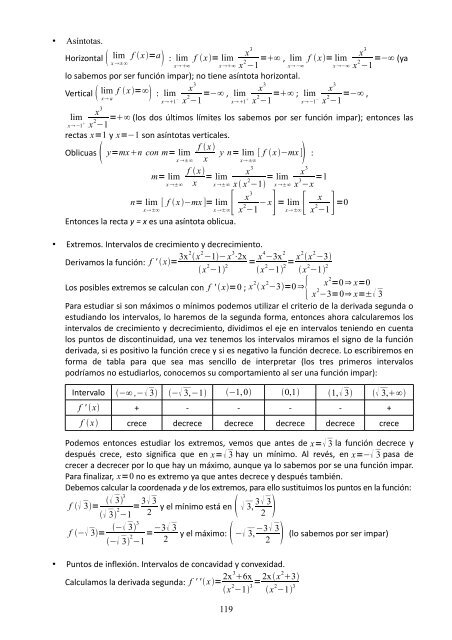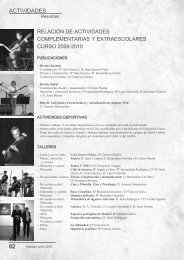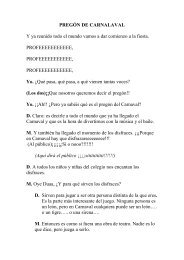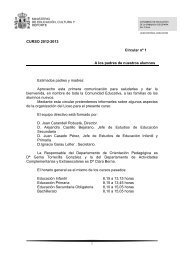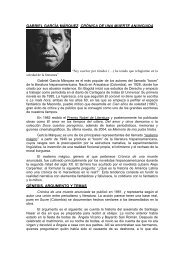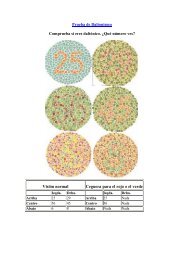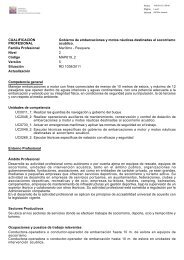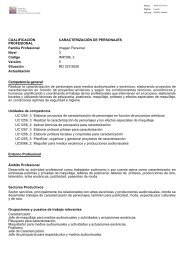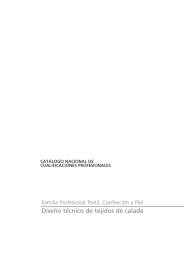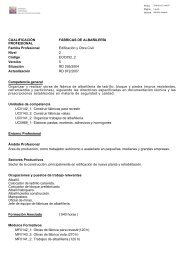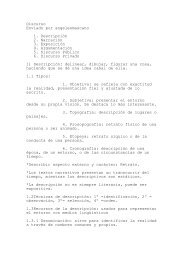MATEMÁTICAS - Ministerio de Educación
MATEMÁTICAS - Ministerio de Educación
MATEMÁTICAS - Ministerio de Educación
You also want an ePaper? Increase the reach of your titles
YUMPU automatically turns print PDFs into web optimized ePapers that Google loves.
• Asíntotas.<br />
Horizontal lim<br />
x ±∞<br />
f x=a : lim<br />
x∞<br />
x<br />
f x= lim<br />
x ∞<br />
3<br />
x 2 =∞ , lim<br />
−1 x−∞<br />
x<br />
f x= lim<br />
x −∞<br />
3<br />
x 2 =−∞ (ya<br />
−1<br />
lo sabemos por ser función impar); no tiene asíntota horizontal.<br />
Vertical lim f x=∞<br />
x a : lim<br />
x1 −<br />
x 3<br />
x 2 =−∞ , lim<br />
−1 x1 <br />
x 3<br />
x 2 =∞ ; lim<br />
−1 x−1 −<br />
x 3<br />
x 2 =−∞ ,<br />
−1<br />
x 3<br />
lim<br />
x−1 x 2 =∞ (los dos últimos límites los sabemos por ser función impar); entonces las<br />
−1<br />
rectas x=1 y x=−1 son asíntotas verticales.<br />
f x<br />
Oblicuas y=mxn con m= lim y n= lim [ f x−mx ] x ±∞ x<br />
x±∞<br />
:<br />
f x x<br />
m= lim = lim<br />
x ±∞ x x ±∞<br />
3<br />
x x 2 x<br />
= lim<br />
−1 x ±∞<br />
3<br />
x 3 −x =1<br />
x<br />
n= lim [ f x−mx ]= lim<br />
x±∞<br />
x ±∞[<br />
3<br />
x 2 x<br />
− x] = lim<br />
−1 x±∞[ x 2 −1] =0<br />
Entonces la recta y = x es una asíntota oblicua.<br />
• Extremos. Intervalos <strong>de</strong> crecimiento y <strong>de</strong>crecimiento.<br />
Derivamos la función: f ' x= 3x2 x 2 −1− x 3 ⋅2x<br />
x 2 −1 2 = x4−3x 2<br />
x 2 −1 2 = x2x 2 −3<br />
x 2 −1 2<br />
Los posibles extremos se calculan con f ' x=0 ; x 2 x 2 −3=0⇒{<br />
x 2 =0⇒ x=0<br />
x 2 −3=0⇒ x=± 3<br />
Para estudiar si son máximos o mínimos po<strong>de</strong>mos utilizar el criterio <strong>de</strong> la <strong>de</strong>rivada segunda o<br />
estudiando los intervalos, lo haremos <strong>de</strong> la segunda forma, entonces ahora calcularemos los<br />
intervalos <strong>de</strong> crecimiento y <strong>de</strong>crecimiento, dividimos el eje en intervalos teniendo en cuenta<br />
los puntos <strong>de</strong> discontinuidad, una vez tenemos los intervalos miramos el signo <strong>de</strong> la función<br />
<strong>de</strong>rivada, si es positivo la función crece y si es negativo la función <strong>de</strong>crece. Lo escribiremos en<br />
forma <strong>de</strong> tabla para que sea mas sencillo <strong>de</strong> interpretar (los tres primeros intervalos<br />
podríamos no estudiarlos, conocemos su comportamiento al ser una función impar):<br />
Intervalo −∞ ,− 3 − 3,−1 −1,0 0,1 1, 3 3,∞<br />
f ' x + - - - - +<br />
f x crece <strong>de</strong>crece <strong>de</strong>crece <strong>de</strong>crece <strong>de</strong>crece crece<br />
Po<strong>de</strong>mos entonces estudiar los extremos, vemos que antes <strong>de</strong> x= 3 la función <strong>de</strong>crece y<br />
<strong>de</strong>spués crece, esto significa que en x= 3 hay un mínimo. Al revés, en x=− 3 pasa <strong>de</strong><br />
crecer a <strong>de</strong>crecer por lo que hay un máximo, aunque ya lo sabemos por se una función impar.<br />
Para finalizar, x=0 no es extremo ya que antes <strong>de</strong>crece y <strong>de</strong>spués también.<br />
Debemos calcular la coor<strong>de</strong>nada y <strong>de</strong> los extremos, para ello sustituimos los puntos en la función:<br />
<br />
f <br />
33<br />
3=<br />
3 2<br />
3 3<br />
=<br />
−1 2 y el mínimo está en 3 3 3,<br />
2 <br />
− 33<br />
f − 3=<br />
− 3 2<br />
3<br />
=−3<br />
−3<br />
y el máximo:<br />
−1 2 −<br />
3<br />
3,<br />
2 (lo sabemos por ser impar)<br />
• Puntos <strong>de</strong> inflexión. Intervalos <strong>de</strong> concavidad y convexidad.<br />
Calculamos la <strong>de</strong>rivada segunda: f ' ' x= 2x36x x 2 −1 3 = 2x x23 x 2 −1 3<br />
119


